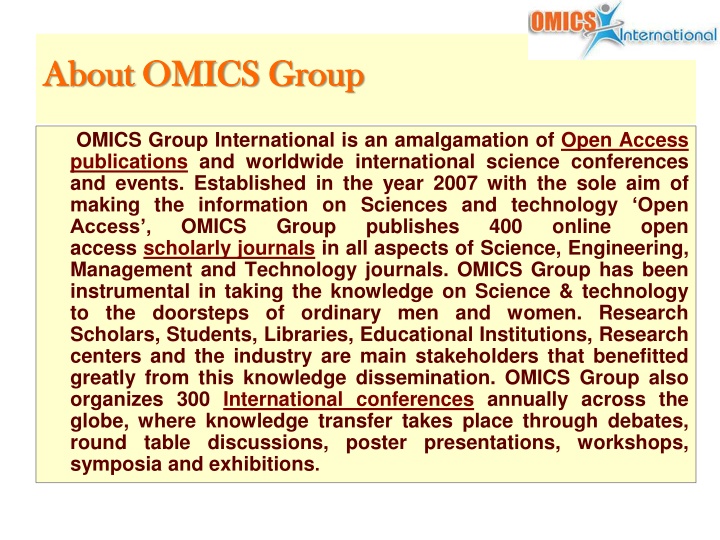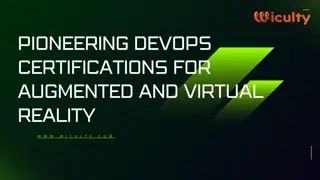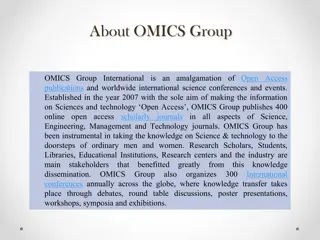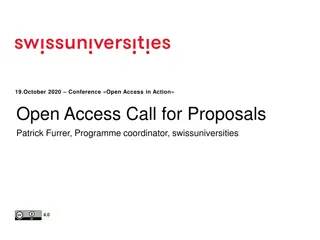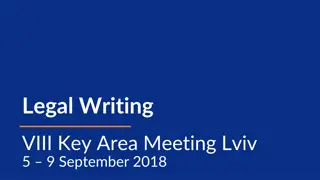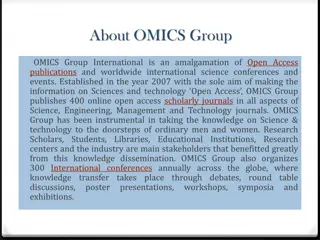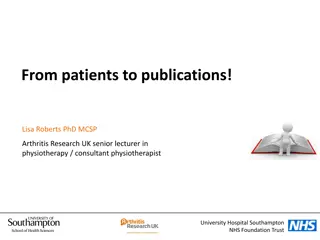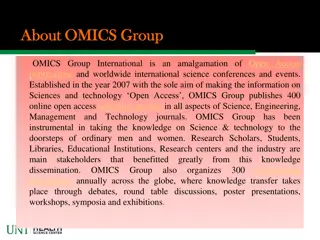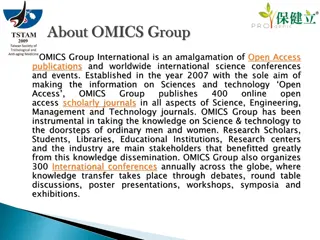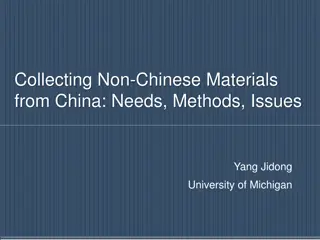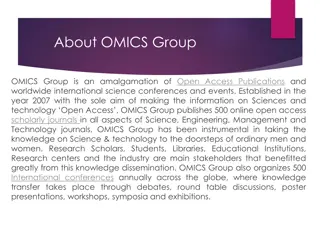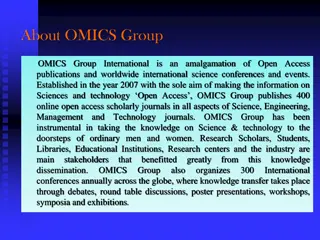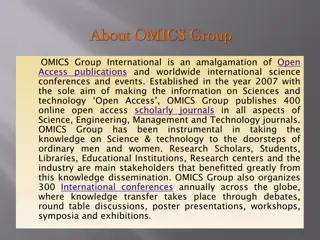OMICS Group: Pioneering Open Access Publications and International Science Events
OMICS Group International is a renowned publisher of open access journals across various fields of science, engineering, management, and technology. Established in 2007, they organize over 300 international conferences annually, facilitating knowledge dissemination and networking in global scientific communities. Their initiatives have greatly benefited research scholars, students, institutions, and industry professionals worldwide.
Download Presentation

Please find below an Image/Link to download the presentation.
The content on the website is provided AS IS for your information and personal use only. It may not be sold, licensed, or shared on other websites without obtaining consent from the author.If you encounter any issues during the download, it is possible that the publisher has removed the file from their server.
You are allowed to download the files provided on this website for personal or commercial use, subject to the condition that they are used lawfully. All files are the property of their respective owners.
The content on the website is provided AS IS for your information and personal use only. It may not be sold, licensed, or shared on other websites without obtaining consent from the author.
E N D
Presentation Transcript
About OMICS Group About OMICS Group OMICS Group International is an amalgamation of Open Access publications and worldwide international science conferences and events. Established in the year 2007 with the sole aim of making the information on Sciences and technology Open Access , OMICS Group publishes access scholarly journals in all aspects of Science, Engineering, Management and Technology journals. OMICS Group has been instrumental in taking the knowledge on Science & technology to the doorsteps of ordinary men and women. Research Scholars, Students, Libraries, Educational Institutions, Research centers and the industry are main stakeholders that benefitted greatly from this knowledge dissemination. OMICS Group also organizes 300 International conferences annually across the globe, where knowledge transfer takes place through debates, round table discussions, poster presentations, workshops, symposia and exhibitions. 400 online open
About OMICS Group Conferences About OMICS Group Conferences OMICS Group International is a pioneer and leading science event organizer, which publishes around 400 open access journals and conducts over 300 Medical, Clinical, Engineering, Life Sciences, Pharma scientific conferences all over the globe annually with the support of more than 1000 scientific associations and 30,000 editorial board members and 3.5 million followers to its credit. OMICS Group has organized 500 conferences, workshops and national symposiums across the major cities including San Francisco, Las Vegas, San Antonio, Omaha, Orlando, Raleigh, Santa Clara, Chicago, Philadelphia, Baltimore, United Kingdom, Valencia, Dubai, Beijing, Hyderabad, Bengaluru and Mumbai.
The Theoretical Optimization of a Cylindrical Body of Rotation Using Magnus Effect Lift Nate Callender Middle Tennessee State University
Background Kutta-Joukowski theorem gives lift as a function of circulation Prandtl s lifting line theory leads to an optimized circulation distribution Robins-Magnus effect produces lift via friction driven circulation
Lifting Line Theory Finite wing represented by horseshoe vortex Superposition of a finite number of horseshoe vortices Superposition of an infinite number of horseshoe vortices yielding a distribution of circulation Figures from Anderson's Fundamentals of Aerodynamics
Lifting Line Theory cont. Circulation distribution Lift from integration
Minimum Induced Drag Induced drag coefficient from lifting line theory Span efficiency factor General circulation distribution 0 e 1 Elliptical circulation distribution e = 1 Munk derived the theoretically optimum chord distribution for a finite wing 2 2? ? c ? = c0 1
Robins-Magnus Effect Figures from Anderson s Fundamentals of Aerodynamics and Prandtl s and Tietjen s Applied Hydro- and Aeromechanics
Current State of the Art Nonrotating infinite cylinders Rotating 2D cylinders
Nonrotating Circular Cylinders 100 10 CD 1 0.1 1.E-01 1.E+00 1.E+01 1.E+02 1.E+03 1.E+04 1.E+05 1.E+06 Re
Rotating Circular Cylinders Prandtl s theoretical maximum lift coefficient Experiment has shown higher values Numerical studies have shown values even higher
Rotating Circular Cylinders Definitions: Uniform stream: Tangential velocity of the cylinder s surface: Ratio of surface velocity to uniform stream:
Rotating Circular Cylinders Studies to date have been two dimensional Analytical: 2-D Experimental: Full span End plates Numerical: 2-D End plates Researcher(s) Investigation Type ????? ? ? ?? ? ??? Prandtl - - 2 Analytical, 2D 4? Reid Experimental, 2D 9.5 7.8 2.5 4 104 Ou & Burns 2.38 Numerical, 2D 6.25 4.6 2 102 Karabelas et al. 2 Numerical, 2D 2.3 4.7 5 106 Chew, Cheng, &Luo Numerical, 2D 9.1 4 2 1 103 Stojkovic, Breur, & - 5.5Numerical, 2D 2?? 1 102 Durst Tokumaru & Dimotakis - 10 Experimental, 2D 15.4 3.8 103 Mittal & Kumar - Numerical, 2D 27 5 2 102 Padrino & Joseph - Numerical, 2D 34 6 4 102 * This was the highest achieved in testing but no absolute maximum was identified.
Rotating Circular Cylinders Constant Diameter Circular Cylinders (CDCC)
Theoretical Goal The goal is to theoretically optimize the lifting, rotating cylinder by developing the three dimensional cylindrical geometry that will create an elliptical circulation distribution.
Bodies of Revolution Spheroids were considered first Elliptic planform Elliptic velocity distribution at the surface due to rotation however
Bodies of Revolution cont. When beginning with a prolate spheroid geometry: Parabolic circulation distribution
Bodies of Revolution cont. Must begin with the elliptic circulation distribution and solve for the appropriate geometry: Biquadratic Body of Revolution (BBOR)
Bodies of Revolution cont. Prolate Spheroid Biquadratic Body of Revolution
Circulation Distributions 3 Elliptical (Biquadratic) Parabolic (Spheroid) 2 1 0 -6 -5 -4 -3 -2 -1 0 1 2 3 4 5 6
